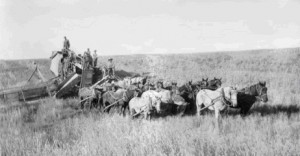Life on the Farm— Guest Blogger — Jack Costello
I am pleased to share with you a piece written by Norman’s Uncle Jack about life on a wheat farm in Eastern Washington in the early part of the twentieth century. This was written for a family reunion in 1992. This is the first part, two others will follow in the coming weeks. The words are all Uncle Jack’s; I have added some pictures.

John Thomas Costello (born 1874 in California) left agricultural pursuits long enough to rise to the rank of fireman on the Northern Pacific, which even at that time (circa 1904) had to be an early accomplishment. In June 1906 he married Elizabeth McDonald, a teacher, who was born near Walla Walla and had moved to Sprague with her family. She deserves equal credit for the success of the farm and of their large family. He later stated that his reason for returning to farming was “You never make it working for somebody else.” It was a challenging era and posterity should have some knowledge and, hopefully, some appreciation for “early times” and their farming forebears.
Many Americans at that time were involved in agriculture, so it was not unusual that John Thomas, like his parents before him, turned to farming. Owning land then was a significant matter of pride and accomplishment for those that did.

While the city dweller and the professional or more formally educated might exhibit some feeling of superiority, those unassociated or actively involved could not appreciate the farmer’s station. With the advent of the internal combustion engine and the mechanical revolution, the industry is very different. The modern farm is “cash crop” oriented, highly mechanized with all of the conveniences, with transportation facilities that permit easy farm equipment mobility and nothing specific in domicile requirements. This significant change in farm life began around 1930 when tractors replaced the work horse.
Farmers have always been noted for their self-reliance and independence, sometimes at a terrible price, they actually had no alternative. The farmer saved and provided-or went without. Considering all of the manual labor required, was the farmer more peasant than entrepreneur? Owning their “place”, as the farm was referred to, then adding acreage as a good crop allowed, was an obsession with a farmer. The owners of the King Ranch in Texas lived by the rule of “buy land and never sell”. What farmer was different?
Top priority was for care of the animals, especially the horses, which usually numbered around 30. Here was the power needed to pull the equipment for tilling and harvesting. They also pulled the wagons, loaded with sacked wheat, the eight miles over rough roads to market. Several months of the year horses could be pastured on range land where they would graze on native grass, but for the most part they were held in or near the farm and had to be fed hay and grain daily. The feed was part of the crop. Hay was cut for winter storage as roads were cut through the growing wheat to make way for the harvesting combine that followed a few weeks later. Without these roads through standing grain, 20-odd head of horses would move through and destroy the wheat in front of the combine (the combine’s cutting device was off to the right side). The work horses, large animals weighing 1500 to 1800 pounds apiece, could easily consume their weight in hay and grain each year. Since their output would not vary significantly from their intake, disposal of tons of manure was an added task. As draft animals, feet and shoulders were in jeopardy. The shoulder problems required medication or adjustment to the harness, but work horses also needed horseshoes. In modern times the farrier’s is a specialized craft, but farmers became blacksmiths and did their own.
Veterinary services were expensive and not readily available. Stud service, however, was provided by a circuit rider that made a business of it. This was selective breeding to provide large, strong stock. Since the stallions lack the preferred temperament, all male foal went under the knife. Professional horse traders are prototypes to auto dealers (especially used cars) but for the most part the farmers looked to their own mares to provide replacement stock. Rendering companies were not available to dispose of a dead animal’s carcass so nature was again employed. Remains were removed to a remote location of the farm, there to await the coyote or carrion friends.
Of all the many chores and challenges presented by horses, the one most probably requiring most judgment and organizing skill was the selection of teams. Horses are of all types, from placid and gentle to spirited and mean. Most operations required only a few horses at one time but the combine harvester usually called for 24 or more. Arranging these teams into a harmonious unit was a test of real horse sense. If disagreement arose in the ranks, harness could be broken and other calamities occur, all resulting in delay.
Arranging these teams into a harmonious unit was a test of real horse sense. If disagreement arose in the ranks, harness could be broken and other calamities occur, all resulting in delay.
The off-season winter months were times to repair and replace harness. Each horse was custom-fitted with approximately 20 pounds of heavy gauge strap leather. A shoemaker’s set of tools, with rivets and heavy waxed thread, was the mainstay of this operation. The equipment and skill that the farmer used to maintain 25 to 30 sets of harness also enabled him to keep his family’s footwear in good repair.
While the horse was the prime mover and first in priorities, a successful family farm required a full complement of domestic animals. With no “butter and egg” man serving rural areas, milk cows, at least two, were a requisite. The cow produced milk only after having giving birth (after a gestation period of nine months). With only one cow, a farmer’s family would be without milk for several months each year. Reproduction, as usual, involved the male of the species. Unlike the equine with delivered stud services, the bovine reversed procedures and made the farmer deliver the female to the bull’s quarters. Fresh milk, cream, and butter were all accepted as standard fare, but an important by-product essential to the family’s wellbeing was an abundance of skim milk to feed pigs. Their population ranged from 2 or 3 to 10 or 12, depending on the presence of brood sows. In their absence, young pigs (weaner pigs) were purchased. Chickens ran free, which made egg gathering a real detective chore. Nests had to be discovered before mother hen decided to start setting, which would be bad business for fertile eggs. But that is another chapter under the heading “kid’s work”.
The farm dog, “man’s best friend”, fueled only by table scraps, worked like the rest. Due to the incompatibility of chickens and hunting dogs, farm dogs ran to the working types. The Costello’s Max was a generic dog, black and white, with some semblance to a shepherd, and smart.

While Max could assist in moving horses, his real worth was demonstrated when cows figured in. Although never many cows, bringing them in for evening milking was “kid’s work” and Max helped if needed. It gave him an opportunity to grandstand a bit because he knew cows, unlike horses, can’t kick while running. The procedure started with a loud, clear call for Max, directed more toward the cows than the dog. Same cows, same dog, no need for the kids. When the cows heard the call for Max, they would head for the barn. The smart dog got a pat on the head, and the smart cows got milked. No shaggy dog story-this is the way it was.

Thanks Kerry,
One more installment left, probably next week.
Judy
Thanks Kerry,
Next installment next week or the week after.
Wow–fantastic! Can’t wait to read the next installment.